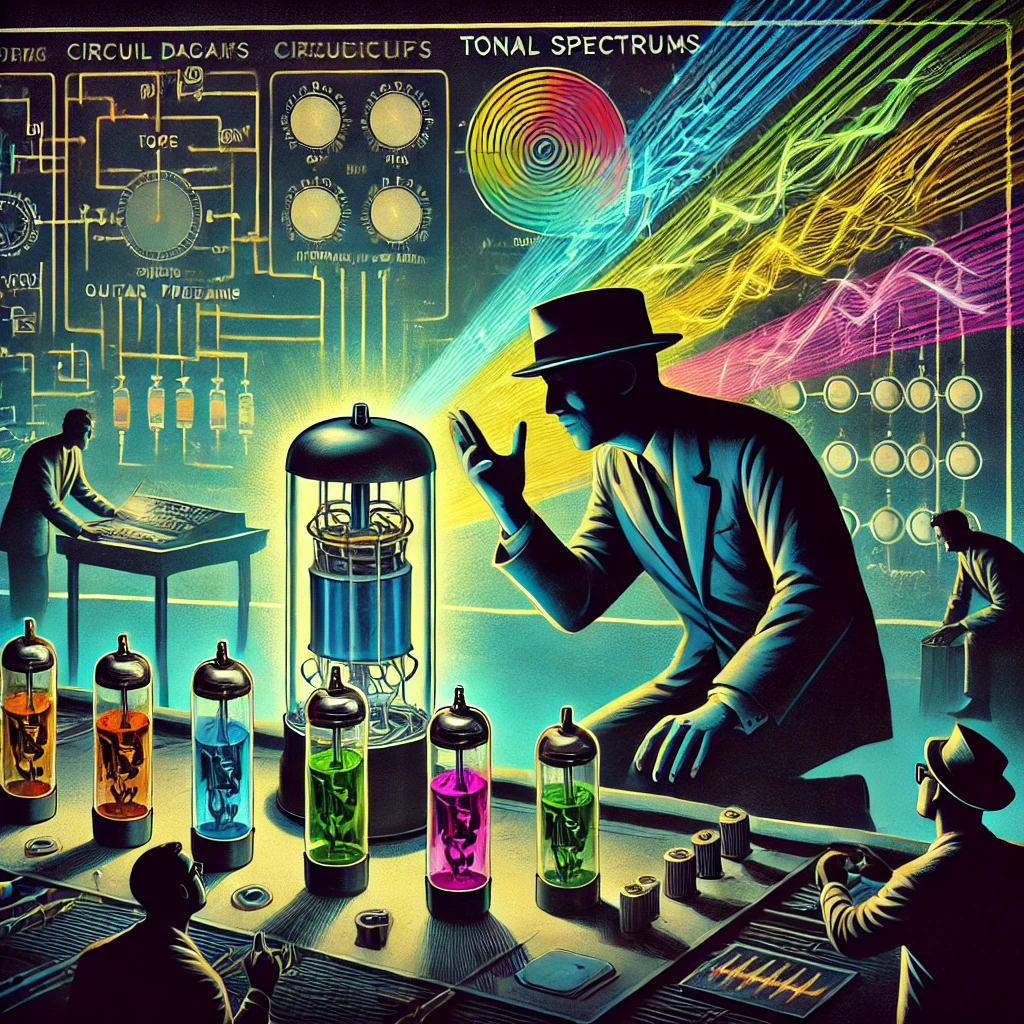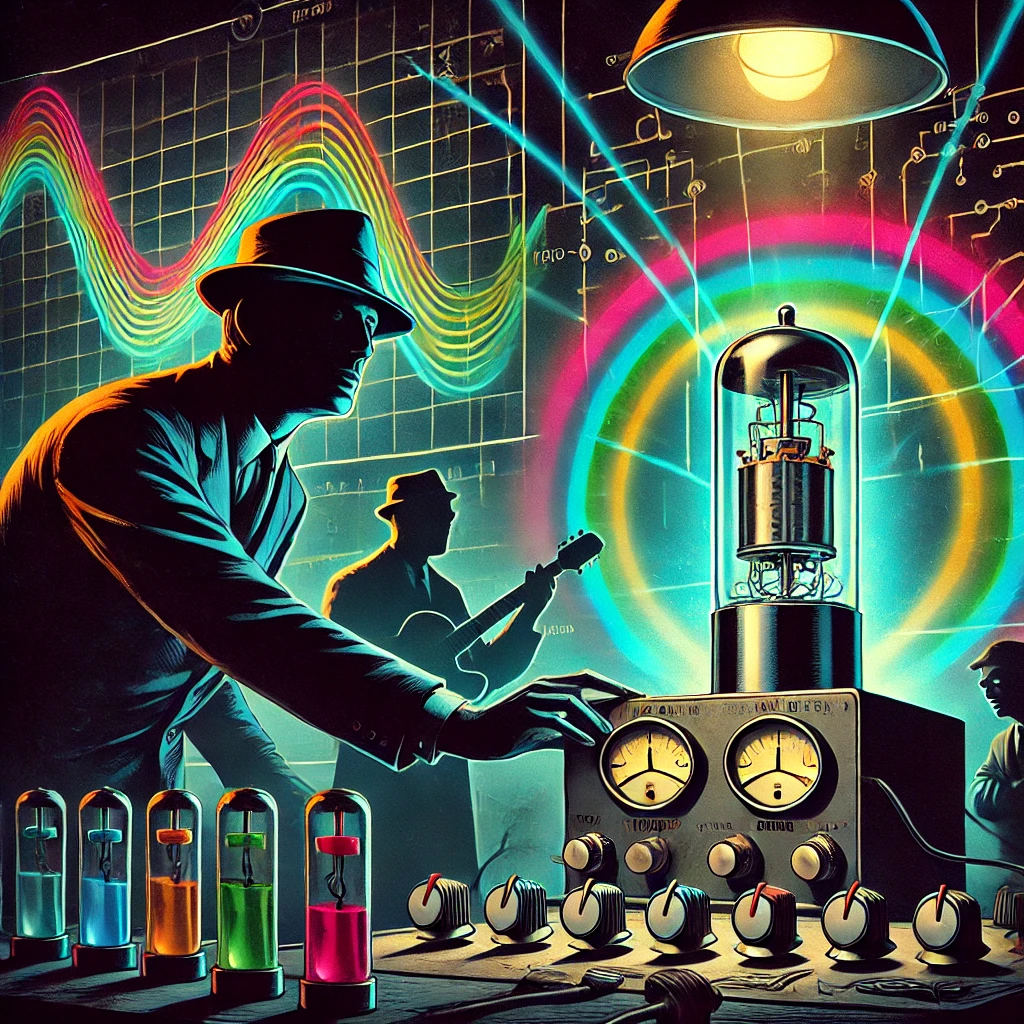Guitar Preamp Tone Explained
Guitar Preamp Tone Explained
by Phil Taylor
For images and entire article: http://www.effectrode.com/blackbird-vacuum-tube-preamp/guitar-preamp-tone-explained/
During the research and development of the ‘Blackbird’ vacuum tube preamp I undertook a thorough investigation into tube preamp circuits in a quest to discover just what factors are important in creating great guitar tone. The following article is a result of those labours . . .
The interplay between your guitar, amp and playing technique are all fundamental to your tone. Your amp responds or reacts in a certain way to the signal from your guitar pickup, the pickup responds to the way you pick the strings and in turn you react to the sound you hear coming from your amp. The whole system is a closed loop with the implication that your guitar and amp will influence your playing in a significant way – the right guitar and amp setup will let your playing soar whilst the wrong setup will hold you back, keeping you well and truely grounded. It’s impossible to over-emphasise the importance of the relationship between gear and musician – it’s certainly worth delving into the science a little and discovering what makes great tone. This article specifically explores tube guitar preamp circuitry – the aim is to demystify the tube sound, give a clear explanation of what’s happening within the preamp, and gain an insight into how guitar legends created their wonderful, classic guitar sounds.
What’s Inside?
Grounded cathode amplifier
Figure 1 – Common cathode tube amplifer.
Your tube amp is made up of a preamp section and power amp section, both of these contribute to the overall tone and feel of the amp. Figure 1 on the left shows a typical tube preamp stage. This type of circuit is called a common cathode gain stage and is found in many classic Fender amps, including the early Deluxe and Twin Reverb ‘Blackface’ and ‘Silverface’ amps. This circuit is a standard building block for amplifier circuits and is used by many other amp manufacturers including Soldano, Boogie, Marshall and Effectrode in their effects pedals. This circuit turns a small voltage into a large voltage – it’s a voltage amplifier. With a 12AX7 tube in there this circuit gives about 30dB of voltage gain, with a 12AU7 expect about 15dB of gain. In a typical vintage amp this gain stage is followed by passive tonestack and then a power stage drive section.
Tube Distortion
Signal amplification
Figure 2 – Amplification of a signal.
Distortion is low in this type of amplifier circuit as the 1K8 cathode resistor sets the bias point right in the middle of the tube’s linear region as shown in Figure 2. Figure 2 shows the ‘transfer function’ or ‘load line’ for this amplifier. The small input voltage (x-axis) controls anode current (y-axis) flowing through the tube to give amplification. This centre biased amplifier section has the maximum threshold of clipping possible (highest headroom), that is where the grid can be fed with the largest possible signal before clipping. Another way of putting it, is to say the input sensitivity of the stage is at its lowest (input sensitivity describes the input voltage required to drive the stage into the non-linear region on the curve and cause clipping). Consequently, this is a very clean sounding amplifier and introduces relatively little distortion into the signal – early guitar amp manufacturers weren’t striving to generate huge amounts of overdrive and sustain with their circuits, just amplify the signal so the guitar could be heard above the drums.
The non-linearity inherent in tubes means that there will always be small amounts of distortion introduced into the signal, even with a clean amp such as the Fender Twin. This is partly explains why a tube amp sounds warmer and has a more musical character than a solid-state amp. The sound of many great Rock ‘n’ Roll players such as Ritchie Valens, Buddy Holly and Chuck Berry were defined by amps with cathode follower preamp stages. Although the preamp section of these amps is relatively clean sounding, the power amp section generates significantly more signal distortion, especially when the amp is cranked up. The distortion is the result of several factors including:
The power amp tubes entering the clipping region
The rectifier tube voltage sagging
The transformer core becoming saturated
The speaker cone resonances and/or break-up
This subject, however, is outside the scope of this article – so let’s get back to the preamp section.
Symmetrical Clipping
Symmetrical tube clipping
Figure 3 – Symmetrical clipping distortion.
This preamp section can be made to distort (in a very pleasant way) if fed with a large enough signal and that’s exactly what guitarists did during the late 60s and early 70s. Players like Alex Lifeson, Jimmy Page and Robin Trower pushed their amps into distortion by placing a boost pedal before their rig (typically a wall of Hi-watt or Marshall tube heads feeding into 4 x 12 cabs!). Because the bias point of the first amp section is roughly in the middle of the load line, the guitar signal is clipped roughly equally on both sides – symmetrical clipping as shown in Figure 3.
Symmetrical clipping produces a mixture of odd and even order harmonics creating the classic rock distortion tone. What you’re hearing when you use a boost pedal is actually your tube amp distorting – that is, a significant amount of the tonal character of the overdrive tone is generated by the amp. Figure 4 shows a frequency analysis of a centre-biased 12AX7 being overdriven. The fundamental is a 440Hz sine wave (‘A’) and strong 3rd, 5th, 7th, etc harmonics are clearly present in the output signal. Even harmonics are also present, however at reduced amplitude in comparison to the odd harmonics. Although centre biased symmetric clipping distortion is beginning to approach a square wave, the rounded edges ensure that brittle-sounding high order harmonics are absent. Incidentally, a true square-wave is made up of a series of only odd harmonics – this is the kind of distortion produced by hard-clipping diode circuits found in opamp based stompboxes such as the Boss DS-1.
Symmetrical tube clipping
Figure 4 – Symmetrical clipping produces a signal with strong odd order harmonics.
Asymmetrical Clipping
Hot biasing
Figure 5 – Hot Biased asymmetrical clipping distortion.
It wasn’t long before designers began experimenting with multi-stage tube preamplifier circuits – pioneers of the art include Alexander Dumble, Randall Smith and Mike Soldano. Their amps contained several tube stages in series (typically four stages) to massively boost the input signal until it went outside the linear region of the tube. Additionally, by manipulating the bias point on the load line they could exercise a degree of control over the input sensitivity in each stage of the amp so that the signal clipped in a more controlled manner. Because the bias point is offset from the centre of the load line, the output signal clips to a greater extent on one half of the cycle than the other – this is asymmetric clipping. Reducing the value of the 1K8 cathode resistor causes more anode current to flow so that the tube runs physically hot. This shifts the bias point to the right-hand end of the load line and the output signal will be clipped on the positive cycle of the output signal – this is called grid current limiting and is shown in Figure 5. A moderate amount of hot biasing produces a smooth, warm and ‘bluesy’ drive, too much and the sound becomes more aggressive and ‘fuzzy’
Cold biasing
Figure 6 – Cold Biased asymmetrical clipping distortion
The bias point can also be shifted to the left-hand end of the load line by increasing the value of the cathode resistor to reduce the current flowing in the anode – this is called cold biasing. This generates cut-off clipping on the negative cycle of the output signal producing a ‘crunchier’, ‘harder-edged’ distortion as shown in Figure 6. Cold biasing is used in many modern triode high gain tube amp designs as it adds rich, harmonic content giving a ‘heavier’ and ‘crunchier’ distortion tone.
Asymmetric clipping generates a signal rich in even and odd order harmonic overtones. The second harmonic is particulary strong (see Figure 7 below), which is almost certainly one of the reasons tube amps sound so musical – the second harmonic is exactly one octave above the fundamental. Both symmetric and asymmetric clipping occur in a multi-stage tube preamp and it will consequently produce a tone that is a complex mix of even and odd order harmonics. Designing an an amp is an art and involves a substantial amount of experimentation in the quest to discover the ideal biasing point, interstage tone-shaping and gain for each stage. The biasing point of each tube stage affects how the stages interact to produce distortion, ultimately defining the core tone of the amp – whether it is glassy clean, warm and bluesy, classic rock or creamy and sustaining.
PDF – Guitar Preamp Tone Explained _ Effectrode
http://www.effectrode.com/blackbird-vacuum-tube-preamp/guitar-preamp-tone-explained/
Phil Taylor, founder of Effectrode, is a renowned expert in guitar electronics and amplification. His work focuses on designing high-quality guitar effects pedals and tube-driven preamps known for their exceptional tone and versatility.
In Taylor’s explanations of guitar preamp tone, he delves into the intricacies of tube-driven circuits and their impact on the overall sound of an electric guitar. Here are some key points that Taylor may cover:
1. Tube Characteristics: Taylor may discuss the unique sonic qualities of vacuum tubes, also known as valves, and their influence on guitar tone. Tubes can produce warm, harmonically rich tones that are highly prized by guitarists for their musicality and responsiveness.
2. Preamp Circuit Design: Taylor may explain the design principles behind guitar preamp circuits, including the choice of components such as resistors, capacitors, and transformers. He may discuss how different circuit topologies, such as single-ended, push-pull, and cascading gain stages, affect the overall tone and dynamics of the amplifier.
3. Gain Staging: Taylor may discuss the importance of gain staging in achieving optimal tone and signal clarity. Proper gain staging ensures that the signal remains free from distortion and noise while still providing enough amplification to drive the power amp section of the amplifier.
4. Tone Controls: Taylor may explain the function of tone controls, such as bass, midrange, and treble knobs, in shaping the frequency response of the amplifier. He may discuss how these controls interact with the preamp circuitry to tailor the tone to the player’s preferences.
5. Dynamic Response: Taylor may highlight the dynamic response of tube-driven preamps and how they react to changes in playing technique and guitar volume. Tube amplifiers are known for their touch-sensitive response, where subtle variations in picking intensity and guitar settings can result in significant changes in tone.
6. Pedal Integration: Taylor may discuss how guitar preamps can be used in conjunction with effects pedals to further shape and enhance the tone. He may provide tips on how to best integrate preamp pedals into a pedalboard setup for maximum flexibility and sonic versatility.
Overall, Phil Taylor’s explanations of guitar preamp tone are likely to be comprehensive and insightful, drawing on his extensive experience in designing high-quality tube-driven circuits for guitar amplification. His expertise in this field makes his insights valuable for guitarists seeking to understand and optimize their tone.

